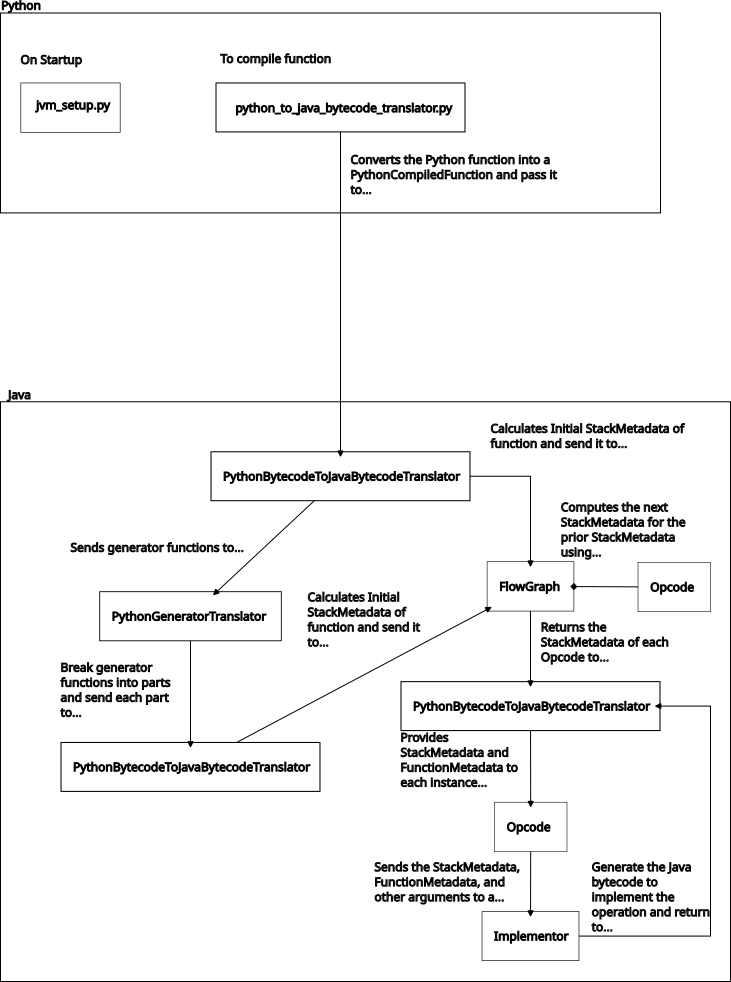JPyInterpreter Architecture
The architecture of JPyInterpreter is composed of several components spread across Python and Java. The Python components are:
-
jvm_setup.py, which sets up the JVM and the hooks JPyInterpreter uses to communicate with CPython (to look up packages, call native methods, and converting CPython object to Java object and vice-versa). -
python_to_java_bytecode_translator.py, which acts as the Python’s frontend to JPyInterpreter. Users supply a CPython function to translate (and an optional Java functional interface it implements) totranslate_python_bytecode_to_java_bytecode, which firsts converts that function to aPythonCompiledFunction, and then passes it toPythonBytecodeToJavaBytecodeTranslatorto translate the function. It also provides thetranslate_python_class_to_java_classfunction, which is given a user supplied CPython class, converts it to aPythonCompiledClass, and passes it toPythonClassTranslatorto translate the class.
The Java components are:
-
PythonBytecodeToJavaBytecodeTranslator, which acts as the entrypoint for function translation. It is responsible for:-
Setting up the
JavaPythonClassWriterandMethodVisitorused for bytecode generation. -
Creating and setting fields on the generated class objects (See PythonBytecodeToJavaBytecodeTranslator for details).
-
Do the leg work of moving/translating Java parameters (ex:
int) intoPythonLikeObject. -
Setup cells variables.
-
Delegating to
PythonGeneratorTranslatorwhen it detects the function being translated is a generator. -
Using
FlowGraphto calculate theStackMetadataof each instruction. -
Calling the
implementmethod on every opcode in theOpcodelist with theStackMetadatafor the opcode and theFunctionMetadatafor the overall function.
-
-
PythonGeneratorTranslatoris likePythonBytecodeToJavaBytecodeTranslatorbut for generators. It breaks a single generator function into multipleadvancefunctions, and generates eachadvancefunction bytecode independently. -
FlowGraph, which calculates theStackMetadatathat corresponds to eachOpcode. It is responsible for unifying theStackMetadatafrom all jump sources for eachOpcodethat is a jump target. For instance, if two sources with the same target have postStackMetadataof… intand… boolrespectively,FlowGraphwill unify that to… int(sinceboolis a subclass ofint, for better or worse). -
StackMetadatastores metadata about the stack and local variables. EachOpcodeget its ownStackMetadatainstance. It is mostly used to perform optimizations; for instance, if we detect the top two items on the stack areintandintfor theBINARY_ADDinstruction, we can change the (normally complex due to Python semantics)BINARY_ADDbytecode into a single method call. -
FunctionMetadatastores metadata about the function (for instance, theMethodVisitorto use to generate bytecode). EachOpcodegets the sameFunctionMetadatainstance. -
Opcodeare the interface between CPython opcodes and theImplementors. Each describe a particular operation, and usually (but not always) correspond to a CPython opcode. Some CPython opcodes map to the sameOpcodeimplementation. -
Implementorsare responsible for generating the Java bytecode corresponding to CPython bytecode. They can be found in theimplementorspackage.
The overall process of compiling a function looks like this:

Types
The builtin types for JPyInterpreter can be found in the types package.
They all implement PythonLikeObject, the interface the bytecode uses to represent arbitrary objects.
If type flow analysis determines a more specific type can be used (via StackMetadata), the more specific type is used directly instead.
PythonLikeObject have several methods:
-
__getAttributeOrNull: returns the attribute with the given name if it exists, otherwise returns null. This is NOT__getattribute__(which is implemented by$method$__getattribute__instead). This is more akin toself.__dict__[attribute]. The default$method$__getattribute__uses it to get the attribute (with additional magic to handle descriptors, see the Python descriptor tutorial for more detail). -
__getAttributeOrError: returns the attribute with the given name if it exists, otherwise raisesAttributeError. Used in bytecode generation to lookup methods on types. -
__setAttribute: sets the attribute with the given name to the given value. This is NOT__setattr__(which is implemented by$method$__setattr__instead). This is more akin toself.__dict__[attribute] = value. The default$method$__setattr__uses it to set the attribute. -
__deleteAttribute: deletes the attribute with the given name. This is NOT__delattr__(which is implemented by$method$__delattr__instead). This is more akin todel self.__dict__[attribute]. The default$method$__delattr__uses it to delete the attribute. -
__getType: returns the type of the object. Used to implementtype(object). -
__getGenericType: returns the generic type of the object (ex:list[int]). Used for typeflow analysis. -
$method$<method-name>: the builtin methods on every object in Python. The$method$<method-name>naming is to allow custom classes to override them (custom classes prefix method names with$method$to not clash with Java method names).
PythonBytecodeToJavaBytecodeTranslator
The entrypoint for function translation, and the glue code for the many subsystems of the translator.
It is responsible for setting up the JavaPythonClassWriter, MethodVisitor and configuring the class' fields.
The fields it configures are:
-
co_consts: Static; aList<PythonLikeObject>that stores constants used in the bytecode. -
co_names: Static; aList<PythonString>that stores names used in the bytecode. -
co_varnames: Static; aList<PythonString>that stores variable names used in the bytecode. -
__globals__: Static; aMap<String, PythonLikeObject>used to read and store globals. -
__spec_getter__: Static; aBiFunction<PythonLikeTuple, PythonLikeDict, ArgumentSpec<PythonLikeObject>>that maps default arguments (which are per function) to anArgumentSpecthat can be used to set parameters. -
__defaults__: Instance; aPythonLikeTuplethat stores default positional arguments. -
__kwdefaults__: Instance; aPythonLikeDictthat stores default keyword arguments. -
__annotations__: Instance; aPythonLikeDictthat stores type annotations on the function. -
__closure__: Instance; aPythonLikeTuplethat stores the function’s closure (i.e. the free variable cells). -
__qualname__: Instance; aPythonStringthat stores the qualified name of the function. -
__spec__: Instance; anArgumentSpecthat can be used to receive parameter (and correctly handle default arguments). -
__interpreter__: Instance; thePythonInterpreterthis function runs in (used to perform imports and lookup unknown globals).
If a Python function cannot be translated for any reason (ex: native code), the following fields are also added:
-
__code__: Static; an opaque pointer to the function’s CPython code object (used in the construct to make the wrapped CPython function). -
__function__: Instance; aPythonObjectWrapperthat wraps the CPython function (used to call the CPython function).